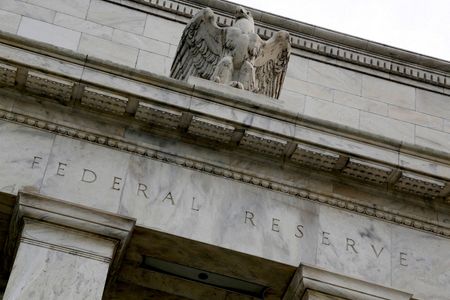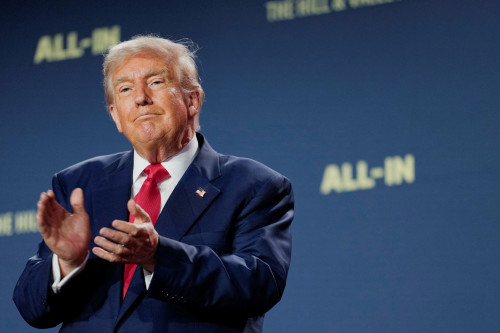NEW YORK (Reuters) -The Federal Reserve left interest rates unchanged on Wednesday but took a major step towards lowering them in coming months in a policy statement that tempered inflation concerns with other risks to the economy and dropped a longstanding reference to possible further hikes in borrowing costs.
MARKET REACTION:
STOCKS: The S&P 500 extended declines and was recently down 1.3%
BONDS: The U.S. Treasury 10-year yield initially rose before reversing course and recently stood at around 3.984%. The 2-year yield was last at 4.258%.
FOREX: The dollar index was volatile, alternating between gains and losses and was last up 0.14%.
COMMENTS:
KEITH LERNER, CHIEF MARKET STRATEGIST, TRUIST WEALTH, ATLANTA
“What Powell is doing is that he’s preserving flexibility because we still have some data ahead of us, like employment and inflation data. He’s preserving some of that flexibility and he’s still providing the direction that the Fed is going to be moving to easing stance. So markets were bouncing around a lot, but in general it’s in line with expectations and not a major shift. But him being more direct and forcefully pushing back against a March cut is a net negative. That’s why you were seeing small caps getting hit more, immediately after he said that. I think that’s meaningful.”
BILL STRAZZULLO, CHIEF MARKET STRATEGIST, BELL CURVE TRADING, BOSTON
“I look at the equity market and I think there’s basically two path here. One path is that market can’t rally unless we get significant rate relief, meaning that the economy is weak and it really needs to be propped up by lower rates. The second path, in the Fed’s own words, is growing at a solid pace and you’ve got a strong labor market, and it would benefit from some rate relief at the lower end – maybe three cuts. And I think this is the path we’re on. It’s a much more sustainable path: the economy is fine and is expanding at solid pace, the labor market is still strong, and we don’t need the rate relief that a lot of people thought we needed three or five months ago.”
SEEMA SHAH, CHIEF GLOBAL STRATEGIST, PRINCIPAL ASSET MANAGEMENT, LONDON
“After a month characterized by a flurry of strong economic data but moderating price pressures, it is not surprising that the Fed is reluctant to provide forward guidance for rate cuts. Still, strong labor market and economic activity data is inevitably inserting some hesitation into their projections. Inflation improvement has been considerable, but as long as the underlying economy is so robust, the risk of renewed inflation pressures cannot be ignored.
“With core PCE already trending around 2%, markets want to understand exactly what is required for the policymakers to have ‘greater confidence’ that inflation is moving sustainably towards 2%. Do they just need additional months showing core PCE at 2%, or will they only feel comfortable once there is clear evidence that the labor market is cooling? I’m not sure Powell will deliver clarity and, in any case, it will be equally important to listen to the FOMC speakers in coming weeks as they potentially try to walk back Powell’s comments from today.”
THIERRY ALBERT WIZMAN, GLOBAL FX AND RATES STRATEGIST, MACQUARIE, NEW YORK
“Traders thought that with the shift in the bias towards neutral that the Fed would accompany this pivot with dovish language. But the Fed did not. If anything, the Fed added some hawkish language in the text. I think what the Fed is trying to say is that neutral means neutral. Yes, they are willing to concede that they don’t know the next direction for the fed funds rate, but they’re certainly not going… to prejudge the outlook. In fact, the Fed is saying that they’re not going to reduce the policy rate until inflation is sustainably towards 2% and that’s new language. It’s negative language and it’s hawkish language in that respect.”
KARL SCHAMOTTA, CHIEF MARKET STRATEGIST, CORPAY, TORONTO
“Markets are expressing a little knee jerk disappointment here given that there’s no clear guidance on rate cuts coming in the imminent future. We’re seeing an extremely neutral, non-committal statement here.
“I think the big issue here is that the statement previously had a sentence that referred to additional policy firming. It now says that it the committee is prepared to adjust the stance of monetary policy as appropriate. That is much more neutral than what had been anticipated, I think, and a lot of market participants were hoping for something that suggested that the central bank would adjust policy in support of the economic expansion that had been occurring.”
BRIAN JACOBSEN, CHIEF ECONOMIST, ANNEX WEALTH MANAGEMENT, MENOMONEE FALLS, WISCONSIN
“By saying the risks are in better balance, the Fed is taking baby steps to cutting. March is likely too soon for them to have enough confidence that inflation is moving sustainably to 2%, but it should be appropriate to taper quantitative tightening by then. The offramp from tightening is a long one.”
MICHAEL BROWN, MARKET ANALYST, PEPPERSTONE, LONDON
“A further dovish step from the FOMC this evening, as had been expected, with the policy statement no longer implying a tightening bias, and pointing to the next move indeed being a cut, with reference to “any adjustments” to the fed funds rate replacing the previous allusion to additional policy firming.”
“Nevertheless, it is clear that the Fed are in no hurry to ease as rapidly as the market prices, with further promising inflation data still required in order to unlock the first rate reduction, even if the FOMC’s aims are ‘moving into better balance’.”
ART HOGAN, CHIEF MARKET STRATEGIST, B. RILEY WEALTH, NEW YORK
“It’s very much as expected, there’s no indication of any imminent easing, so I think this is right down the middle of the fairway.”
“Not surprisingly, I don’t think the Fed wants to show their hand, especially, when they have a couple of months of data to collect before they need to. The good news is we can forget about any more tightening. The bad news it’s ‘when’, not ‘if’, they’re going to cut rates, and that ‘when’ has been pushed out to what had been the fringes of consensus.”
(Compiled by the Global Finance & Markets Breaking News team)





